Managerial Finance: Analyzing the Big Mac Index and Its Limitations
VerifiedAdded on 2023/06/04
|9
|2032
|398
Report
AI Summary
This report delves into the Big Mac Index, a unique economic indicator initiated by Pam Woodall, examining its history, methodology, and underlying theory. The report explains how the index, published annually by The Economist, measures purchasing power parity (PPP) between currencies by compa...
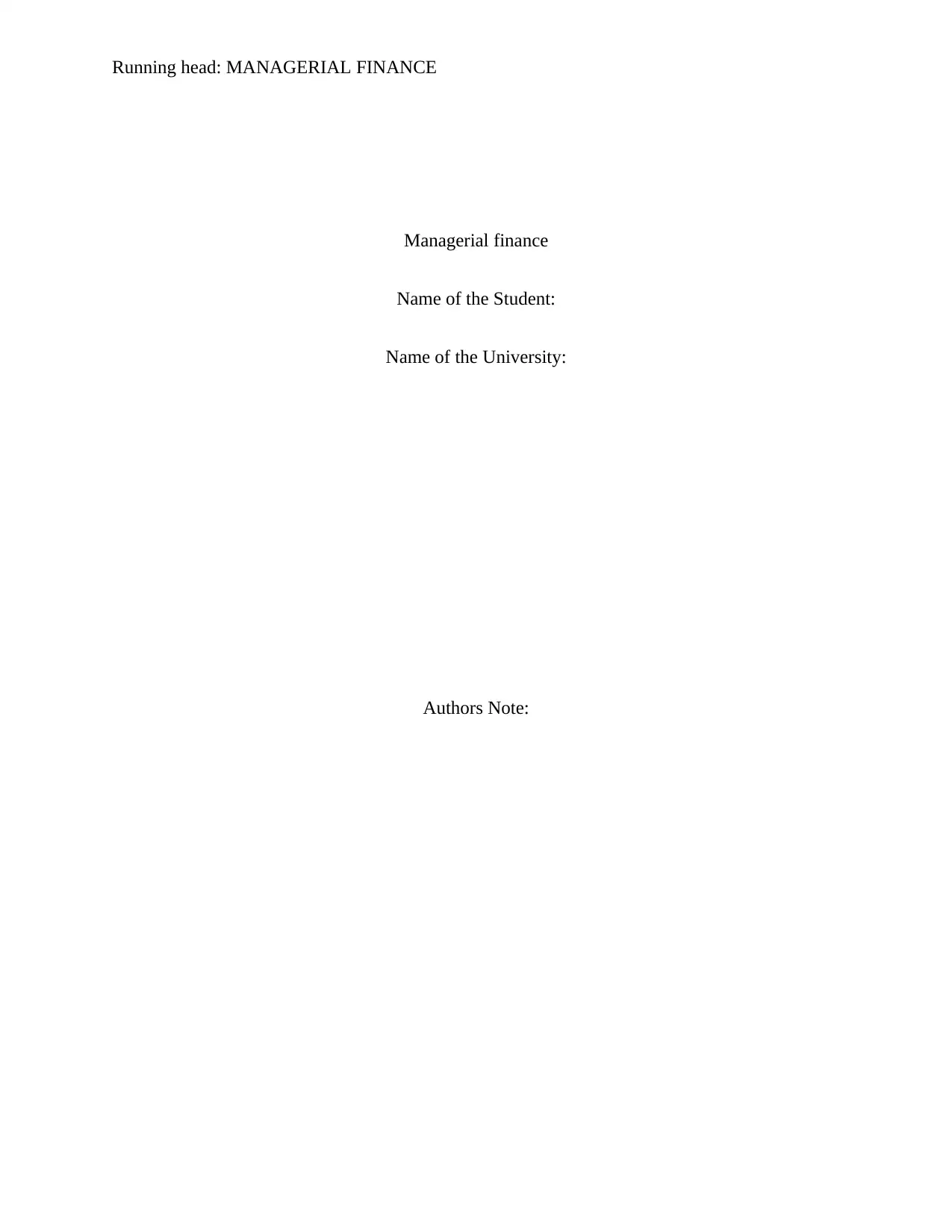
Running head: MANAGERIAL FINANCE
Managerial finance
Name of the Student:
Name of the University:
Authors Note:
Managerial finance
Name of the Student:
Name of the University:
Authors Note:
Paraphrase This Document
Need a fresh take? Get an instant paraphrase of this document with our AI Paraphraser
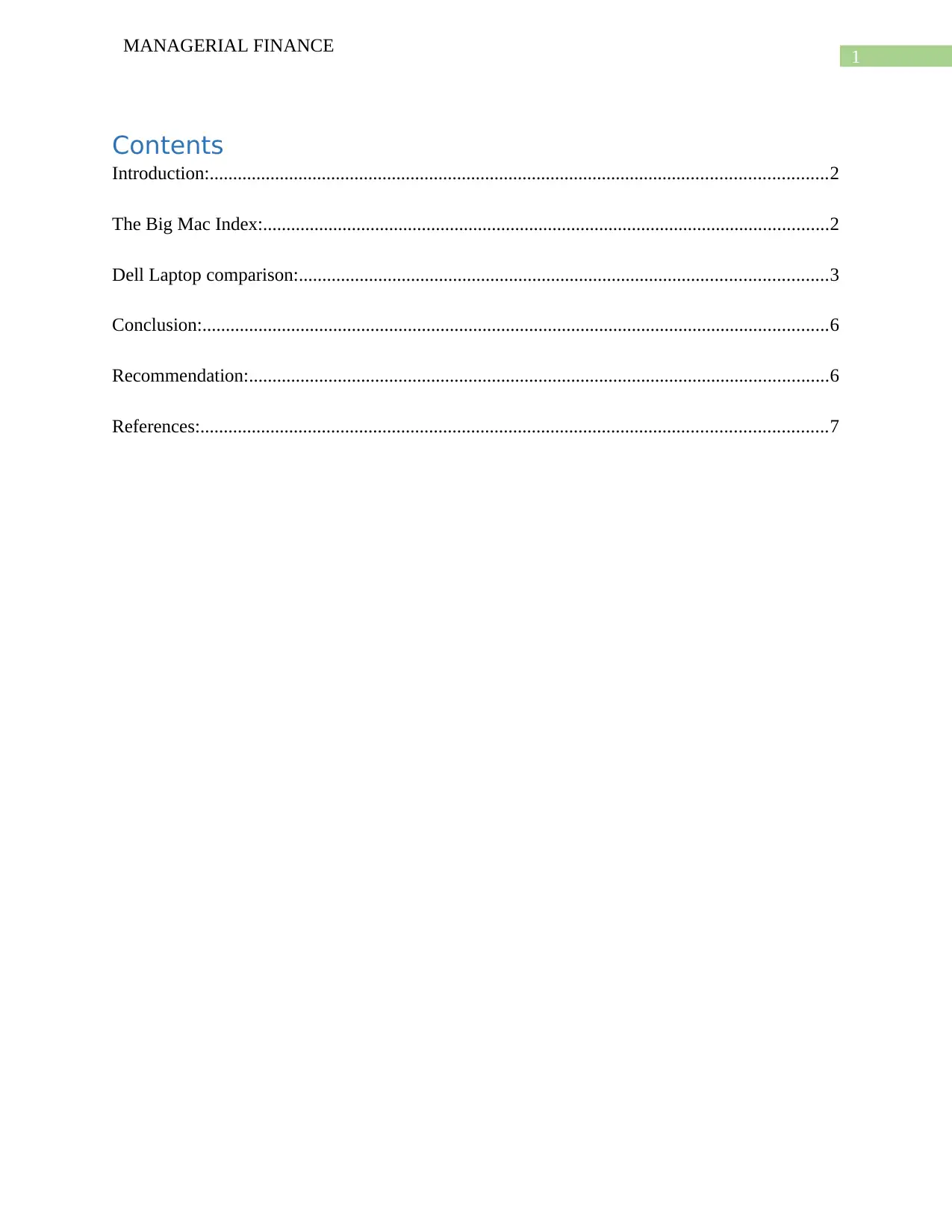
1
MANAGERIAL FINANCE
Contents
Introduction:....................................................................................................................................2
The Big Mac Index:.........................................................................................................................2
Dell Laptop comparison:.................................................................................................................3
Conclusion:......................................................................................................................................6
Recommendation:............................................................................................................................6
References:......................................................................................................................................7
MANAGERIAL FINANCE
Contents
Introduction:....................................................................................................................................2
The Big Mac Index:.........................................................................................................................2
Dell Laptop comparison:.................................................................................................................3
Conclusion:......................................................................................................................................6
Recommendation:............................................................................................................................6
References:......................................................................................................................................7
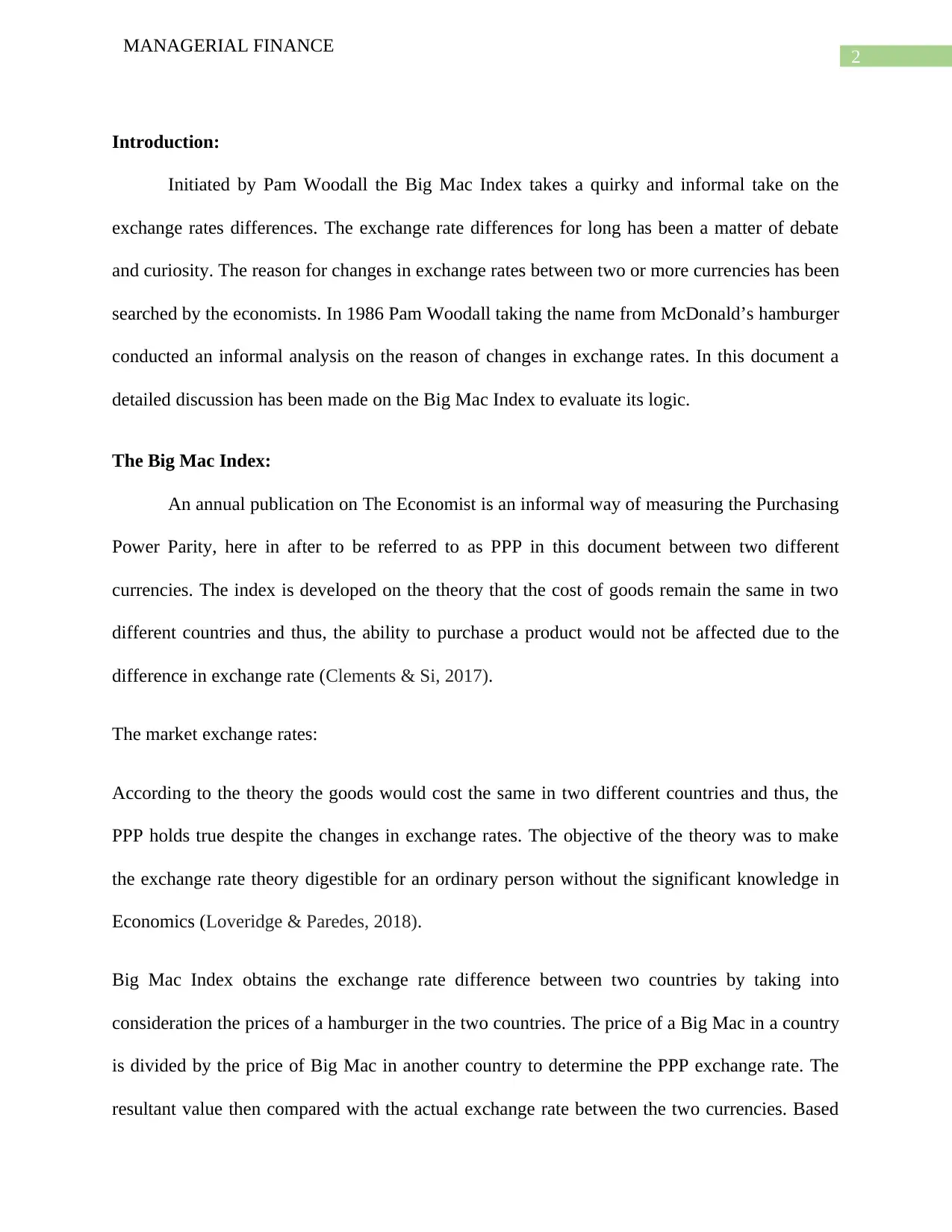
2
MANAGERIAL FINANCE
Introduction:
Initiated by Pam Woodall the Big Mac Index takes a quirky and informal take on the
exchange rates differences. The exchange rate differences for long has been a matter of debate
and curiosity. The reason for changes in exchange rates between two or more currencies has been
searched by the economists. In 1986 Pam Woodall taking the name from McDonald’s hamburger
conducted an informal analysis on the reason of changes in exchange rates. In this document a
detailed discussion has been made on the Big Mac Index to evaluate its logic.
The Big Mac Index:
An annual publication on The Economist is an informal way of measuring the Purchasing
Power Parity, here in after to be referred to as PPP in this document between two different
currencies. The index is developed on the theory that the cost of goods remain the same in two
different countries and thus, the ability to purchase a product would not be affected due to the
difference in exchange rate (Clements & Si, 2017).
The market exchange rates:
According to the theory the goods would cost the same in two different countries and thus, the
PPP holds true despite the changes in exchange rates. The objective of the theory was to make
the exchange rate theory digestible for an ordinary person without the significant knowledge in
Economics (Loveridge & Paredes, 2018).
Big Mac Index obtains the exchange rate difference between two countries by taking into
consideration the prices of a hamburger in the two countries. The price of a Big Mac in a country
is divided by the price of Big Mac in another country to determine the PPP exchange rate. The
resultant value then compared with the actual exchange rate between the two currencies. Based
MANAGERIAL FINANCE
Introduction:
Initiated by Pam Woodall the Big Mac Index takes a quirky and informal take on the
exchange rates differences. The exchange rate differences for long has been a matter of debate
and curiosity. The reason for changes in exchange rates between two or more currencies has been
searched by the economists. In 1986 Pam Woodall taking the name from McDonald’s hamburger
conducted an informal analysis on the reason of changes in exchange rates. In this document a
detailed discussion has been made on the Big Mac Index to evaluate its logic.
The Big Mac Index:
An annual publication on The Economist is an informal way of measuring the Purchasing
Power Parity, here in after to be referred to as PPP in this document between two different
currencies. The index is developed on the theory that the cost of goods remain the same in two
different countries and thus, the ability to purchase a product would not be affected due to the
difference in exchange rate (Clements & Si, 2017).
The market exchange rates:
According to the theory the goods would cost the same in two different countries and thus, the
PPP holds true despite the changes in exchange rates. The objective of the theory was to make
the exchange rate theory digestible for an ordinary person without the significant knowledge in
Economics (Loveridge & Paredes, 2018).
Big Mac Index obtains the exchange rate difference between two countries by taking into
consideration the prices of a hamburger in the two countries. The price of a Big Mac in a country
is divided by the price of Big Mac in another country to determine the PPP exchange rate. The
resultant value then compared with the actual exchange rate between the two currencies. Based
⊘ This is a preview!⊘
Do you want full access?
Subscribe today to unlock all pages.

Trusted by 1+ million students worldwide
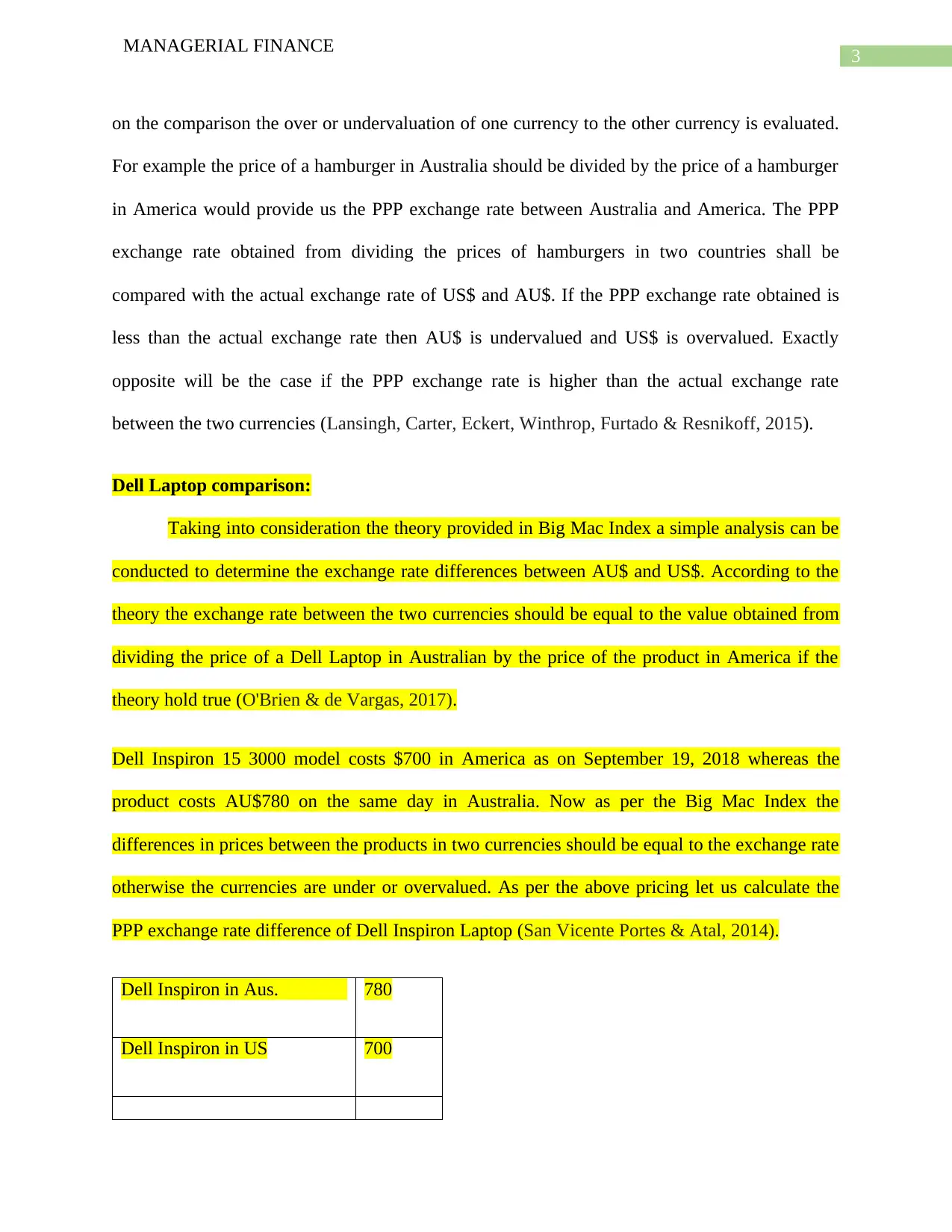
3
MANAGERIAL FINANCE
on the comparison the over or undervaluation of one currency to the other currency is evaluated.
For example the price of a hamburger in Australia should be divided by the price of a hamburger
in America would provide us the PPP exchange rate between Australia and America. The PPP
exchange rate obtained from dividing the prices of hamburgers in two countries shall be
compared with the actual exchange rate of US$ and AU$. If the PPP exchange rate obtained is
less than the actual exchange rate then AU$ is undervalued and US$ is overvalued. Exactly
opposite will be the case if the PPP exchange rate is higher than the actual exchange rate
between the two currencies (Lansingh, Carter, Eckert, Winthrop, Furtado & Resnikoff, 2015).
Dell Laptop comparison:
Taking into consideration the theory provided in Big Mac Index a simple analysis can be
conducted to determine the exchange rate differences between AU$ and US$. According to the
theory the exchange rate between the two currencies should be equal to the value obtained from
dividing the price of a Dell Laptop in Australian by the price of the product in America if the
theory hold true (O'Brien & de Vargas, 2017).
Dell Inspiron 15 3000 model costs $700 in America as on September 19, 2018 whereas the
product costs AU$780 on the same day in Australia. Now as per the Big Mac Index the
differences in prices between the products in two currencies should be equal to the exchange rate
otherwise the currencies are under or overvalued. As per the above pricing let us calculate the
PPP exchange rate difference of Dell Inspiron Laptop (San Vicente Portes & Atal, 2014).
Dell Inspiron in Aus. 780
Dell Inspiron in US 700
MANAGERIAL FINANCE
on the comparison the over or undervaluation of one currency to the other currency is evaluated.
For example the price of a hamburger in Australia should be divided by the price of a hamburger
in America would provide us the PPP exchange rate between Australia and America. The PPP
exchange rate obtained from dividing the prices of hamburgers in two countries shall be
compared with the actual exchange rate of US$ and AU$. If the PPP exchange rate obtained is
less than the actual exchange rate then AU$ is undervalued and US$ is overvalued. Exactly
opposite will be the case if the PPP exchange rate is higher than the actual exchange rate
between the two currencies (Lansingh, Carter, Eckert, Winthrop, Furtado & Resnikoff, 2015).
Dell Laptop comparison:
Taking into consideration the theory provided in Big Mac Index a simple analysis can be
conducted to determine the exchange rate differences between AU$ and US$. According to the
theory the exchange rate between the two currencies should be equal to the value obtained from
dividing the price of a Dell Laptop in Australian by the price of the product in America if the
theory hold true (O'Brien & de Vargas, 2017).
Dell Inspiron 15 3000 model costs $700 in America as on September 19, 2018 whereas the
product costs AU$780 on the same day in Australia. Now as per the Big Mac Index the
differences in prices between the products in two currencies should be equal to the exchange rate
otherwise the currencies are under or overvalued. As per the above pricing let us calculate the
PPP exchange rate difference of Dell Inspiron Laptop (San Vicente Portes & Atal, 2014).
Dell Inspiron in Aus. 780
Dell Inspiron in US 700
Paraphrase This Document
Need a fresh take? Get an instant paraphrase of this document with our AI Paraphraser
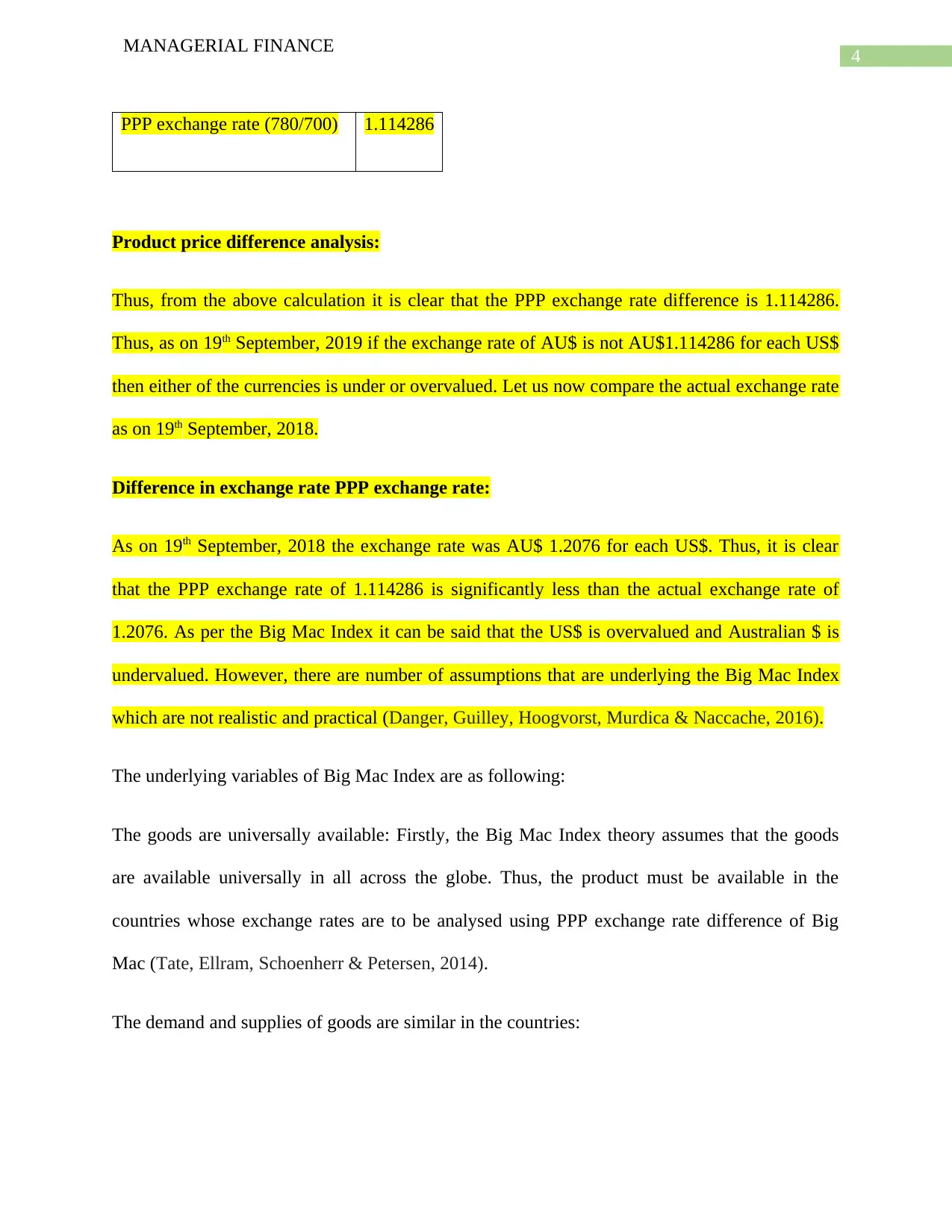
4
MANAGERIAL FINANCE
PPP exchange rate (780/700) 1.114286
Product price difference analysis:
Thus, from the above calculation it is clear that the PPP exchange rate difference is 1.114286.
Thus, as on 19th September, 2019 if the exchange rate of AU$ is not AU$1.114286 for each US$
then either of the currencies is under or overvalued. Let us now compare the actual exchange rate
as on 19th September, 2018.
Difference in exchange rate PPP exchange rate:
As on 19th September, 2018 the exchange rate was AU$ 1.2076 for each US$. Thus, it is clear
that the PPP exchange rate of 1.114286 is significantly less than the actual exchange rate of
1.2076. As per the Big Mac Index it can be said that the US$ is overvalued and Australian $ is
undervalued. However, there are number of assumptions that are underlying the Big Mac Index
which are not realistic and practical (Danger, Guilley, Hoogvorst, Murdica & Naccache, 2016).
The underlying variables of Big Mac Index are as following:
The goods are universally available: Firstly, the Big Mac Index theory assumes that the goods
are available universally in all across the globe. Thus, the product must be available in the
countries whose exchange rates are to be analysed using PPP exchange rate difference of Big
Mac (Tate, Ellram, Schoenherr & Petersen, 2014).
The demand and supplies of goods are similar in the countries:
MANAGERIAL FINANCE
PPP exchange rate (780/700) 1.114286
Product price difference analysis:
Thus, from the above calculation it is clear that the PPP exchange rate difference is 1.114286.
Thus, as on 19th September, 2019 if the exchange rate of AU$ is not AU$1.114286 for each US$
then either of the currencies is under or overvalued. Let us now compare the actual exchange rate
as on 19th September, 2018.
Difference in exchange rate PPP exchange rate:
As on 19th September, 2018 the exchange rate was AU$ 1.2076 for each US$. Thus, it is clear
that the PPP exchange rate of 1.114286 is significantly less than the actual exchange rate of
1.2076. As per the Big Mac Index it can be said that the US$ is overvalued and Australian $ is
undervalued. However, there are number of assumptions that are underlying the Big Mac Index
which are not realistic and practical (Danger, Guilley, Hoogvorst, Murdica & Naccache, 2016).
The underlying variables of Big Mac Index are as following:
The goods are universally available: Firstly, the Big Mac Index theory assumes that the goods
are available universally in all across the globe. Thus, the product must be available in the
countries whose exchange rates are to be analysed using PPP exchange rate difference of Big
Mac (Tate, Ellram, Schoenherr & Petersen, 2014).
The demand and supplies of goods are similar in the countries:
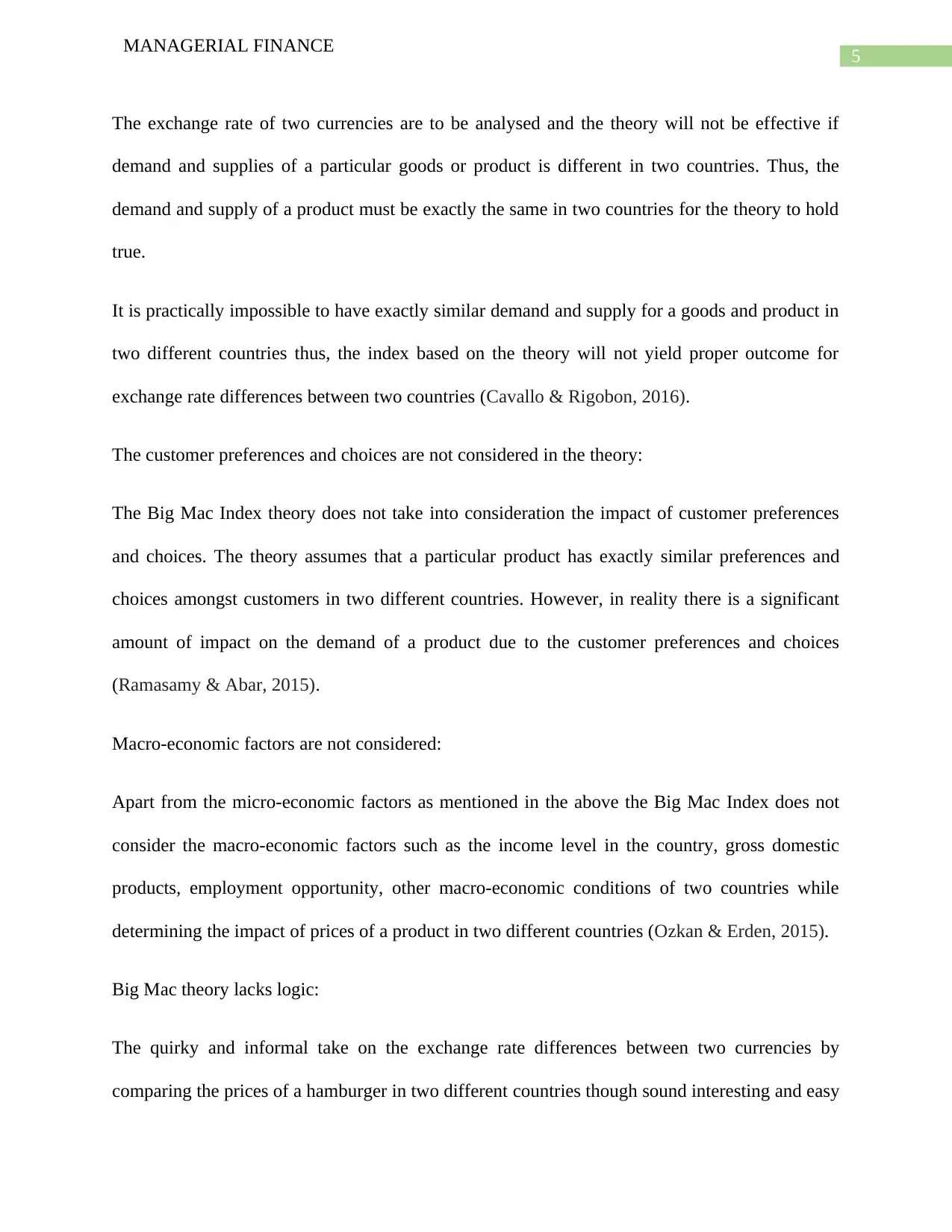
5
MANAGERIAL FINANCE
The exchange rate of two currencies are to be analysed and the theory will not be effective if
demand and supplies of a particular goods or product is different in two countries. Thus, the
demand and supply of a product must be exactly the same in two countries for the theory to hold
true.
It is practically impossible to have exactly similar demand and supply for a goods and product in
two different countries thus, the index based on the theory will not yield proper outcome for
exchange rate differences between two countries (Cavallo & Rigobon, 2016).
The customer preferences and choices are not considered in the theory:
The Big Mac Index theory does not take into consideration the impact of customer preferences
and choices. The theory assumes that a particular product has exactly similar preferences and
choices amongst customers in two different countries. However, in reality there is a significant
amount of impact on the demand of a product due to the customer preferences and choices
(Ramasamy & Abar, 2015).
Macro-economic factors are not considered:
Apart from the micro-economic factors as mentioned in the above the Big Mac Index does not
consider the macro-economic factors such as the income level in the country, gross domestic
products, employment opportunity, other macro-economic conditions of two countries while
determining the impact of prices of a product in two different countries (Ozkan & Erden, 2015).
Big Mac theory lacks logic:
The quirky and informal take on the exchange rate differences between two currencies by
comparing the prices of a hamburger in two different countries though sound interesting and easy
MANAGERIAL FINANCE
The exchange rate of two currencies are to be analysed and the theory will not be effective if
demand and supplies of a particular goods or product is different in two countries. Thus, the
demand and supply of a product must be exactly the same in two countries for the theory to hold
true.
It is practically impossible to have exactly similar demand and supply for a goods and product in
two different countries thus, the index based on the theory will not yield proper outcome for
exchange rate differences between two countries (Cavallo & Rigobon, 2016).
The customer preferences and choices are not considered in the theory:
The Big Mac Index theory does not take into consideration the impact of customer preferences
and choices. The theory assumes that a particular product has exactly similar preferences and
choices amongst customers in two different countries. However, in reality there is a significant
amount of impact on the demand of a product due to the customer preferences and choices
(Ramasamy & Abar, 2015).
Macro-economic factors are not considered:
Apart from the micro-economic factors as mentioned in the above the Big Mac Index does not
consider the macro-economic factors such as the income level in the country, gross domestic
products, employment opportunity, other macro-economic conditions of two countries while
determining the impact of prices of a product in two different countries (Ozkan & Erden, 2015).
Big Mac theory lacks logic:
The quirky and informal take on the exchange rate differences between two currencies by
comparing the prices of a hamburger in two different countries though sound interesting and easy
⊘ This is a preview!⊘
Do you want full access?
Subscribe today to unlock all pages.

Trusted by 1+ million students worldwide
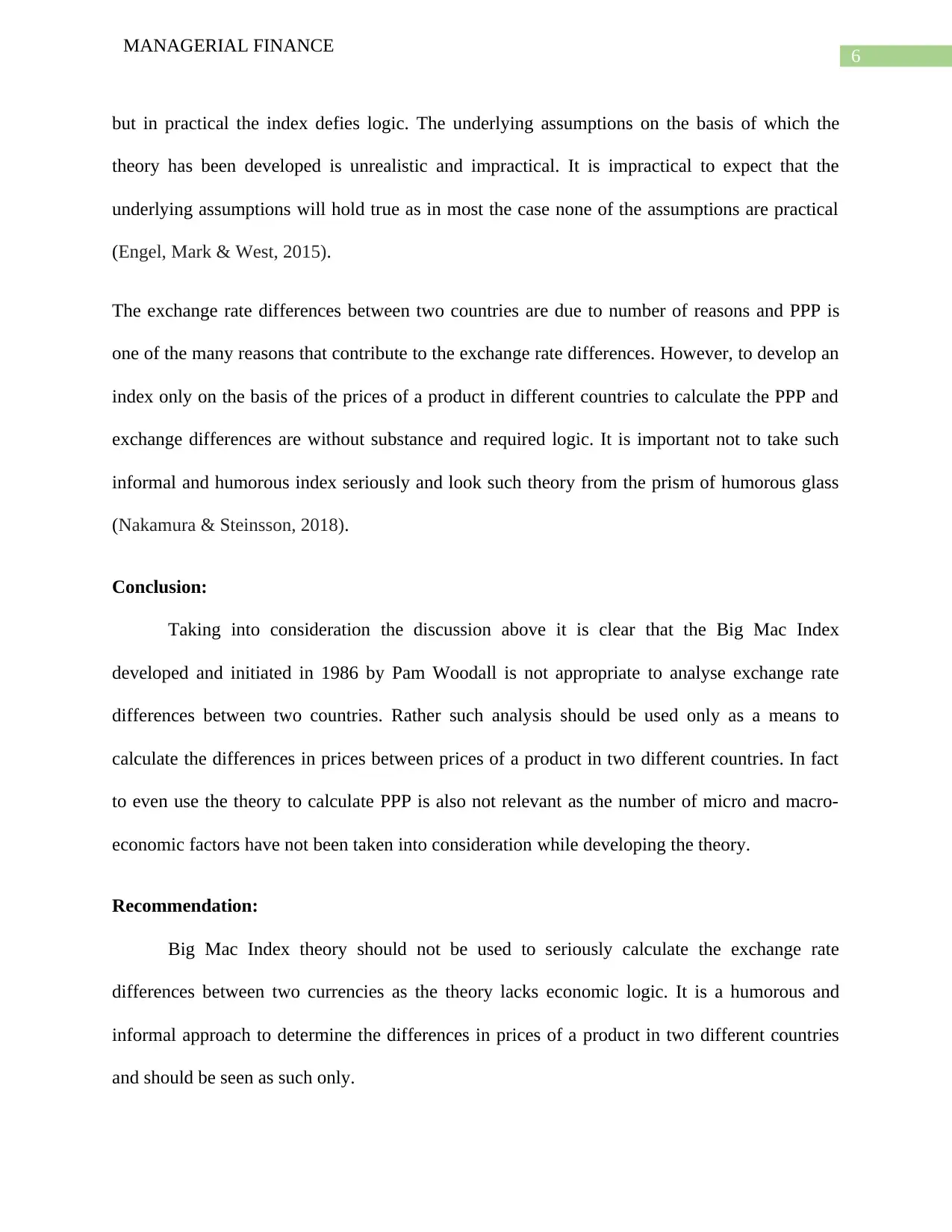
6
MANAGERIAL FINANCE
but in practical the index defies logic. The underlying assumptions on the basis of which the
theory has been developed is unrealistic and impractical. It is impractical to expect that the
underlying assumptions will hold true as in most the case none of the assumptions are practical
(Engel, Mark & West, 2015).
The exchange rate differences between two countries are due to number of reasons and PPP is
one of the many reasons that contribute to the exchange rate differences. However, to develop an
index only on the basis of the prices of a product in different countries to calculate the PPP and
exchange differences are without substance and required logic. It is important not to take such
informal and humorous index seriously and look such theory from the prism of humorous glass
(Nakamura & Steinsson, 2018).
Conclusion:
Taking into consideration the discussion above it is clear that the Big Mac Index
developed and initiated in 1986 by Pam Woodall is not appropriate to analyse exchange rate
differences between two countries. Rather such analysis should be used only as a means to
calculate the differences in prices between prices of a product in two different countries. In fact
to even use the theory to calculate PPP is also not relevant as the number of micro and macro-
economic factors have not been taken into consideration while developing the theory.
Recommendation:
Big Mac Index theory should not be used to seriously calculate the exchange rate
differences between two currencies as the theory lacks economic logic. It is a humorous and
informal approach to determine the differences in prices of a product in two different countries
and should be seen as such only.
MANAGERIAL FINANCE
but in practical the index defies logic. The underlying assumptions on the basis of which the
theory has been developed is unrealistic and impractical. It is impractical to expect that the
underlying assumptions will hold true as in most the case none of the assumptions are practical
(Engel, Mark & West, 2015).
The exchange rate differences between two countries are due to number of reasons and PPP is
one of the many reasons that contribute to the exchange rate differences. However, to develop an
index only on the basis of the prices of a product in different countries to calculate the PPP and
exchange differences are without substance and required logic. It is important not to take such
informal and humorous index seriously and look such theory from the prism of humorous glass
(Nakamura & Steinsson, 2018).
Conclusion:
Taking into consideration the discussion above it is clear that the Big Mac Index
developed and initiated in 1986 by Pam Woodall is not appropriate to analyse exchange rate
differences between two countries. Rather such analysis should be used only as a means to
calculate the differences in prices between prices of a product in two different countries. In fact
to even use the theory to calculate PPP is also not relevant as the number of micro and macro-
economic factors have not been taken into consideration while developing the theory.
Recommendation:
Big Mac Index theory should not be used to seriously calculate the exchange rate
differences between two currencies as the theory lacks economic logic. It is a humorous and
informal approach to determine the differences in prices of a product in two different countries
and should be seen as such only.
Paraphrase This Document
Need a fresh take? Get an instant paraphrase of this document with our AI Paraphraser
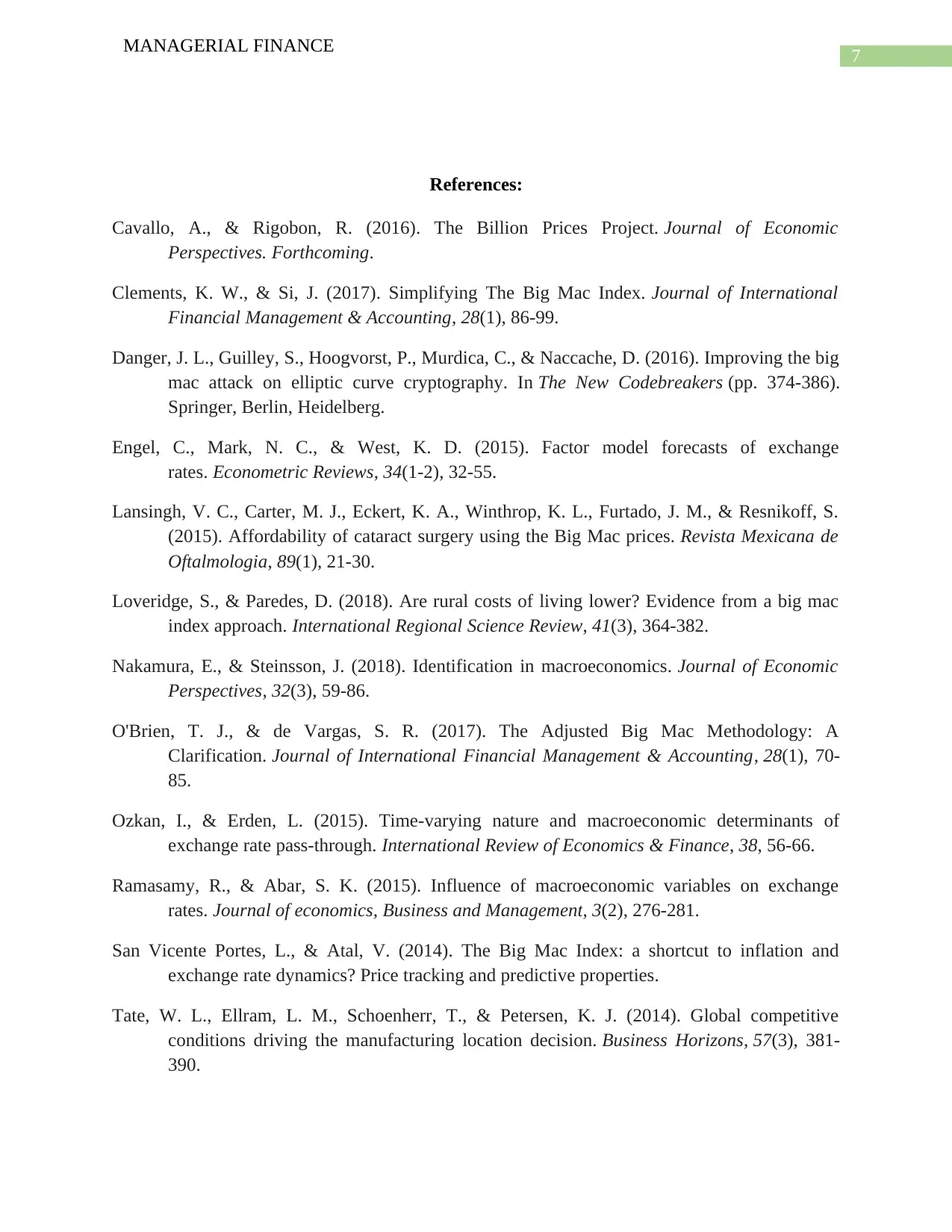
7
MANAGERIAL FINANCE
References:
Cavallo, A., & Rigobon, R. (2016). The Billion Prices Project. Journal of Economic
Perspectives. Forthcoming.
Clements, K. W., & Si, J. (2017). Simplifying The Big Mac Index. Journal of International
Financial Management & Accounting, 28(1), 86-99.
Danger, J. L., Guilley, S., Hoogvorst, P., Murdica, C., & Naccache, D. (2016). Improving the big
mac attack on elliptic curve cryptography. In The New Codebreakers (pp. 374-386).
Springer, Berlin, Heidelberg.
Engel, C., Mark, N. C., & West, K. D. (2015). Factor model forecasts of exchange
rates. Econometric Reviews, 34(1-2), 32-55.
Lansingh, V. C., Carter, M. J., Eckert, K. A., Winthrop, K. L., Furtado, J. M., & Resnikoff, S.
(2015). Affordability of cataract surgery using the Big Mac prices. Revista Mexicana de
Oftalmologia, 89(1), 21-30.
Loveridge, S., & Paredes, D. (2018). Are rural costs of living lower? Evidence from a big mac
index approach. International Regional Science Review, 41(3), 364-382.
Nakamura, E., & Steinsson, J. (2018). Identification in macroeconomics. Journal of Economic
Perspectives, 32(3), 59-86.
O'Brien, T. J., & de Vargas, S. R. (2017). The Adjusted Big Mac Methodology: A
Clarification. Journal of International Financial Management & Accounting, 28(1), 70-
85.
Ozkan, I., & Erden, L. (2015). Time-varying nature and macroeconomic determinants of
exchange rate pass-through. International Review of Economics & Finance, 38, 56-66.
Ramasamy, R., & Abar, S. K. (2015). Influence of macroeconomic variables on exchange
rates. Journal of economics, Business and Management, 3(2), 276-281.
San Vicente Portes, L., & Atal, V. (2014). The Big Mac Index: a shortcut to inflation and
exchange rate dynamics? Price tracking and predictive properties.
Tate, W. L., Ellram, L. M., Schoenherr, T., & Petersen, K. J. (2014). Global competitive
conditions driving the manufacturing location decision. Business Horizons, 57(3), 381-
390.
MANAGERIAL FINANCE
References:
Cavallo, A., & Rigobon, R. (2016). The Billion Prices Project. Journal of Economic
Perspectives. Forthcoming.
Clements, K. W., & Si, J. (2017). Simplifying The Big Mac Index. Journal of International
Financial Management & Accounting, 28(1), 86-99.
Danger, J. L., Guilley, S., Hoogvorst, P., Murdica, C., & Naccache, D. (2016). Improving the big
mac attack on elliptic curve cryptography. In The New Codebreakers (pp. 374-386).
Springer, Berlin, Heidelberg.
Engel, C., Mark, N. C., & West, K. D. (2015). Factor model forecasts of exchange
rates. Econometric Reviews, 34(1-2), 32-55.
Lansingh, V. C., Carter, M. J., Eckert, K. A., Winthrop, K. L., Furtado, J. M., & Resnikoff, S.
(2015). Affordability of cataract surgery using the Big Mac prices. Revista Mexicana de
Oftalmologia, 89(1), 21-30.
Loveridge, S., & Paredes, D. (2018). Are rural costs of living lower? Evidence from a big mac
index approach. International Regional Science Review, 41(3), 364-382.
Nakamura, E., & Steinsson, J. (2018). Identification in macroeconomics. Journal of Economic
Perspectives, 32(3), 59-86.
O'Brien, T. J., & de Vargas, S. R. (2017). The Adjusted Big Mac Methodology: A
Clarification. Journal of International Financial Management & Accounting, 28(1), 70-
85.
Ozkan, I., & Erden, L. (2015). Time-varying nature and macroeconomic determinants of
exchange rate pass-through. International Review of Economics & Finance, 38, 56-66.
Ramasamy, R., & Abar, S. K. (2015). Influence of macroeconomic variables on exchange
rates. Journal of economics, Business and Management, 3(2), 276-281.
San Vicente Portes, L., & Atal, V. (2014). The Big Mac Index: a shortcut to inflation and
exchange rate dynamics? Price tracking and predictive properties.
Tate, W. L., Ellram, L. M., Schoenherr, T., & Petersen, K. J. (2014). Global competitive
conditions driving the manufacturing location decision. Business Horizons, 57(3), 381-
390.

8
MANAGERIAL FINANCE
MANAGERIAL FINANCE
⊘ This is a preview!⊘
Do you want full access?
Subscribe today to unlock all pages.

Trusted by 1+ million students worldwide
1 out of 9
Related Documents
Your All-in-One AI-Powered Toolkit for Academic Success.
+13062052269
info@desklib.com
Available 24*7 on WhatsApp / Email
![[object Object]](/_next/static/media/star-bottom.7253800d.svg)
Unlock your academic potential
© 2024 | Zucol Services PVT LTD | All rights reserved.





